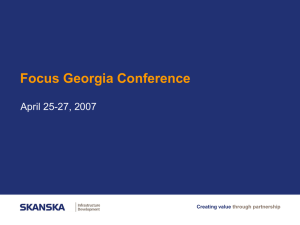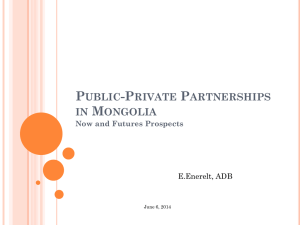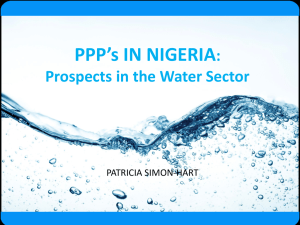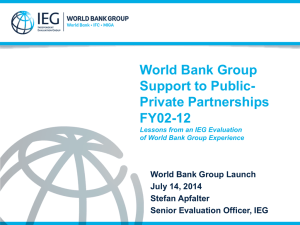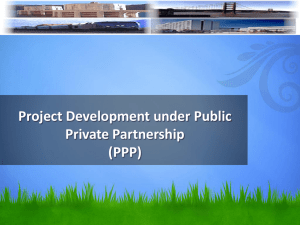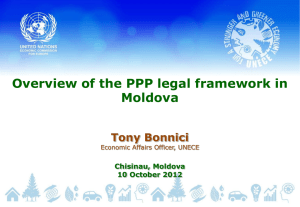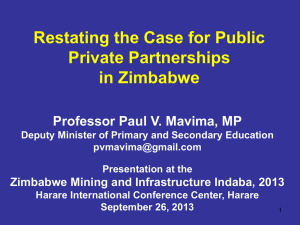Project Development under PPP Models-CEO, IPDF
advertisement
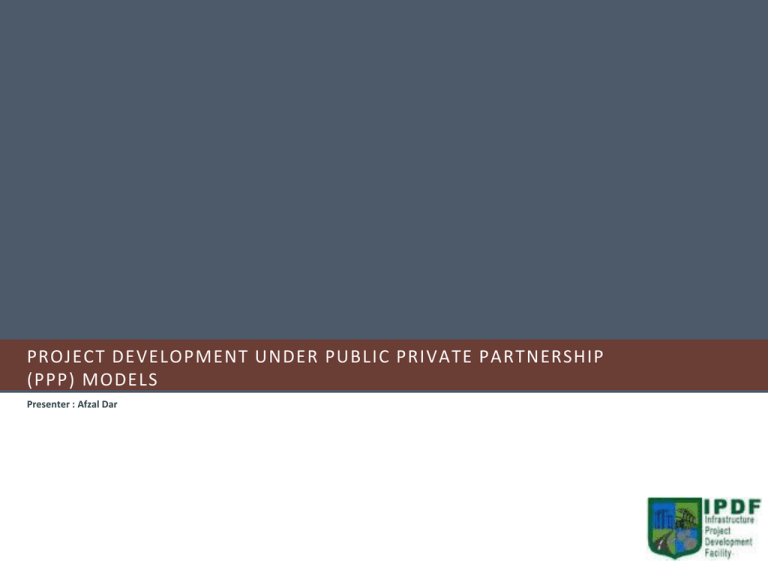
PROJECT DEVELOPMENT UNDER PUBLIC PRIVATE PARTNERSHIP (PPP) MODELS Presenter : Afzal Dar Unit of GOP • IPDF is the central PPP unit of the GOP, incorporated by MOF to facilitate government departments/agencies in developing their infrastructure projects under PPP methodology • Launched by Prime Minister in to act as a bridge between public & private sectors by facilitating infrastructure development Inception under PPP methodology Role of IPDF Sectors • Facilitate the preparation of PPP transactions & the promotion, generation & implementation of PPP projects • Transport & logistics, Mass Urban public transport, municipal services, social sector, energy, etc. INFRASTRUCTURE PROJECT DEVELOPMENT FACILITY Inception& Mandate • IPDF assists in the transaction structuring as well as implementation • Transaction structuring entails conducting a detailed feasibility, needs & options analysis and risk assessment study • Transaction implementation, on the other hand, involves the structuring of the concession agreement on the most suitable Public Private Partnership modality and the procurement of the private party • IPDF is mandated to develop the following enabling framework: • • • • • • Policy Law Standardized Provisions Guidelines for Ministries, Departments and Private Sector Model Concession Agreement Assistance to Provincial Governments in setting-up PPP cells INFRASTRUCTURE PROJECT DEVELOPMENT FACILITY (IPDF) IPDF Mandate PPP: • WHAT IS IT? PPPs: Introduction Medium to long term relationship between the public sector and the partners (including voluntary organisations) Involves sharing and transferring of risks and rewards between public sector and the partners • Attempts to utilise multi-sectoral and multi-disciplinary expertise to structure, finance and deliver desired policy outcomes that are in public interest • Clear governance structures established to manage the partnerships PPPS: INTRODUCTION • PPP : • WH AT IS IT? PPPs: Introduction It is about creating, nurturing and sustaining an effective relationship between the Government and the private sector Achieving improved value for money by utilising the innovative capabilities and skills to deliver performance improvements and efficiency savings. • It aims to leverage private sector expertise and capital to obtain efficiency gains in service delivery and asset creation. • Life-cycle responsibility, value for money, output specification, risk transfer-4 fundamental but challenging aspects of PPP PPPS: INTRODUCTION • PPP: WHAT IS IT? IPDF Introduction Designed to maximize the use of Private Sector Skills • Risk placed where it can be managed best • Activities performed by those most capable • Public and Private Sector each retain their own identity • They collaborate on the basis of a clear division of tasks and risks • PPP offers to the Public Sector greater Value for Money: • PPP transaction facilitates technology transfer • Private Sector shares its experience with Public Sector • PPP delivers high quality infrastructure in the shortest possible time PPPS: INTRODUCTION • 100 % non-public ownership Enabler/ Regulator Divestures BOO Concessions Governments’ Role BOT Leases Management contracts 100 % Public ownership 5 10 15 20 25 30 Increasing level of delegation, risk & irreversibility Duration Provider FORMS OF PUBLIC PRIVATE PARTNERSHIPS(PPP) Service Contracts Key Considerations Full cost recovery Service contracts: Cost-effective way to meet special technical needs, but benefits are limited Management contracts: useful for rapidly enhancing technical capacity, efficiency, and degree of private sector’s involvement Leases: An efficient way to pass on commercial risk. Appropriate when large scope for operating efficiency and limited scope for new investments Concessions: Pass full responsibility for operations and investment to the private sector Build-operate-transfer (BOT) or variations resemble concessions but are normally used for greenfield projects, such as wastewater treatment plant Divestiture / BOO Concession / BOT Water Sector Maturity Lease Management Contract Service Contract Low cost recovery No asset ownership; with operational responsibilities Responsibility of Private Sector Asset ownership with operational and commercial responsibility PPP: VARIOUS OPTIONS PPP Participation vs. Sector Maturity PPP: • Transport WHAT IS IT? Key Sectors • Tourism • Prisons • Municipal Transport System • Municipal Infrastructure such as: • Water • Solid waste management • Wastewater and Sewerage • Parking • Health Care • Education PPPS: SECTORS • Defence and Energy sectors Options • Public policy considerations • Goals of the government • Expectations from the private sector in terms of targets, or service levels to be achieved • Condition & needs of the public sector agency • Political as well as institutional constraints HOW TO DECIDE ON OPTIONS? Depends on: Key Considerations • To spell out a clear partnership process, backed by a strong policy and enabling • Commitment to use PPPs as one of the vehicles for service delivery • Develop a clear and transparent selection process • Real commitment to deliver the project in public interest • Remember that the third P is the key to any successful PPP THE KEY IS… legislative framework; • Internalising PPP process within the public sector • Preparing the PPP environment • Project identification & project development • Preparing the Business Case • Securing competitive bids, negotiation and award • Supporting implementation and operations WHAT ARE THE KEY CHALLENGES? Challenges INFRASTRUCTURE PROJECT DEVELOPMENT FACILITY ( IPDF) & PPP PROCESS (STANDARDIZED APPROACH TO PROJECT DEVELOPMENT) Decision to explore PPP option (I) Register PPP project with IPDF (IPDF/I) Assign Project Manager (IPDF/I) Draft terms of reference and Appoint Transaction Advisor (IPDF/I) Negotiate and finalize contract with Transaction Advisor (IPDF/I) FEASIBILITY STUDY Feasibility Study (TA) Solution option analysis Project due-diligence Value Assessment Financial Assessment Economic Assessment Procurement plan Evaluate recommendations of Transaction Advisor (IPDF/I) Estimate VGF or concessionary requirements (IPDF/I/TA) Market testing (IPDF/TA) Review market test results (IPDF/TA) Determine final PPP design parameters (IPDF/TA/I) Review by IPDF Project Feasibility Committee (IPDF/I/TA) Recommend to IPFF, for long-term fixed rate local currency financing to fill any market gaps (IPDF/TA) If required, project submitted to VGF Committee (IPDF/TA) PROJECT LIFECYCLE AND GUIDELINES INCEPTION PROJECT LIFECYCLE AND GUIDELINES (CONTD.) PROCUREMENT Draft tender documents (RFQ, RFP, draft contract) (IPDF/TA/I) Pre-qualify parties (IPDF/TA/I) Issue request for proposals with draft contract (IPDF/I/TA) Receive bids (IPDF/I/TA) Evaluate bids by comparing bids with feasibility study and each other (IPDF/TA/I) Select preferred bidder and negotiate (IPDF/TA/I) Financial Closure – Agreements finalized and signed (IPDF/TA/I/MOF/Private Party) Close-out report and case study (TA) DEVELOPMENT DELIVERY EXIT 15 INCEPTION Task 1 Task 2 Task 3 Task 4 Task 5 • Decision to explore the PPP Option (I) • Register PPP project with IPDF (IPDF/I) • Assign project manager (IPDF/I) • Draft TORs, RFPs, and Appoint TAs (IPDF/I) • Finalize the contract with TA (IPDF/I) INCEPTION GUIDELINE - TASKS Inception Guidelines Comprise of 5 Tasks Task 3: Assign Project Manager An institution will take the PPP option if; - Project manager is appointed by both, IPDF and - It lacks the financial resources to build, develop institution and is the focal point for both the and implement the project on its own; or parties Lacks the technical expertise to manage and - Project manager manages the PPP project from inception to financial close operate the project; or - The project is complex and requires structuring Task 4: Draft TORs, RFP & Appoint Technical Assistant to make it bankable - RFP is prepared and advertised to invite interested TAs to submit their technical and financial proposals - Task 2: Register PPP Project with IPDF Includes; project description, TORs, evaluation criteria, draft agreement, etc. - The project is brought to IPDF for registration - Proposals submitted by TAs are evaluated - IPDF analyzes whether the project is suitable - Technical Advisor is selected for PPP and whether its in line with the social- Task 5: Finalize the contract with the Technical Assistant environmental safeguards - - Once the project is deemed acceptable IPDF signs a Memorandum of Understanding with the concerned institution - Contract is negotiated with the selected party and legal documentation is complete Negotiations will primarily be on issues related to; - the work plan, deliverables, contract duration and procedure for disbursements/payments. DETAILS OF THE INCEPTION TASKS Task 1: Decision to Explore PPP Option PROJECT PREPARATION/FEASIBILITY GUIDELINES Task 1 Task 2 • Project Pre-feasibility study • Project Feasibility Study PROJECT PREPARATION/ FEASIBILITY GUIDELINES The Objective is to define the Project and to develop a Project Concepts - Determine project’s Technical and Operational feasibility - Project Due Diligence Looks at environmental and social safeguard activities - Financial Assessment - - Assess project cost, income generation potential, payback, financial risks, economic benefits and private sector interest in the project Identify possible modes for private sector participation - - Socio-economic assessment and environment assessment Determine Financial and Economic feasibility of the Project - - Engineering/technical technical/operational risks, etc. - The Options Analysis aspects, - - The Project Feasibility will do the… Identify the role of private sector (investor, JV partner, lender, etc.) Legal documentation for private sector, contractual framework, etc. Highlight Next implementation Steps in the projects’ - Value Assessment - Economic Assessment - Demonstrate Viability - Verify Information and Sign-off - Project management and Procurement Plan - Revisiting Feasibility Study DETAILS ON PROJECT FEASIBILITY TASKS The Project Pre-feasibility will… 1. Need Analysis Demonstrate strategic alignment Estimate the available budget Demonstrate the institution’s commitment and capacity Specify the outputs Define project scope 2. Option Analysis 3. Due Diligence THE FEASIBILITY PROCESS Process Flow of each Step of the Feasibility Phase 5. Value Assessment 6. Economic Assessment 7. Economic Assessment THE FEASIBILITY PROCESS (CONTD.) 4. Financial Assessment Project’s financial viability is examined taking into account project costs & revenues Impact of the project on public sector finances is evaluated 9. Value Assessment Project management plan is devised setting out procedures on how the PPP project will be procured 10. Revisiting the Feasibility Study Change in the project or macroeconomic conditions Update the Feasibility Study THE FEASIBILITY PROCESS (CONTD.) 8. Financial Assessment - Detailed understanding of all aspects of the project - Clear affordability statement – both user charges & unitary payments - Procurement plan - Project team - Output specifications - Funding sources - Payment mechanisms for the private party - Risk matrix and sources of risk with sensitivity analyses - Viability Gap Funding – Initial Approval - Risk Management Framework – Initial Approval OUTCOME OF THE FEASIBILITY STAGE Major Outcomes PROCUREMENT IMPORTANT CONSIDERATIONS FOR PROCUREMENTS Considerations - Should there be an explicit statement of affordability in the RFP? - Parameters for bidding - Time allowed for bid preparation - Risk Allocation and mitigations - Land - Staff - Competition - Bid costs - Existing institution assets - Asset replacement and disposal - Market Test / Expression of interest 27 Prepare and Issue RFQ Bid Preparation and Bid Submission VGF Approval RMF Approval Evaluate RFQ response & Prequalify bidders Prepare & distribute draft RFP document Bid Evaluation & Selection of Preferred Bidder PPP Agreement Signing, Agreement Management Plan & Financial Close Consult with Bidders & distribute Final RFP if required Negotiation with Preferred Bidder Close out Report & Case Study PROCUREMENT PROCESS Process Flow of the Procurement Guidelines REHABILITATE OPERATE TRANSFER (ROT) Application: Retrofit Sewage and Water System BUILD LEASE TRANSFER (BLT) Application: Power Plant, Utilities Sector, Port Terminals BUILD OWN OPERATE (BOO) Application: Telecommunication, Power Plant, Waste Water System BUILD OPERATE TRANSFER (BOT) Application: Develop highway networks, Power Plants, Utilities, Airports & Bus Terminals IPDF – SELECT PROJECTS Line Ministry • Civil Aviation Authority Project Cost • USD 25 Million Concession Period • 30 Years Project Modality • Build, Own, Operate, Transfer (BOOT) Project Scope • Private operator will build fuel farms for storage and dispensing of aviation fuel and petrochemical products at the new BBIA as well as Operate and Maintain (O&M) the Hydrant Refueling System (HRS). Financials • Internal Rate of Return (IRR) - 22% • Project Net Present Value NPV) – USD. 235 million • Payback period – 5-6 years Current Status • The contract is set to be awarded to Pakistan State Oil (PSO) IPDF – SELECT PPP PROJECTS Fuel Farm at New Benazir Bhutto International Airport Project Line Ministry • Pakistan Railway Project Cost • USD 327 Million Concession Period • 20 Years Project Modality • Finance, Own, Operate (FOO) Project Scope • Private operator(s) to operate freight and passenger trains on the Track of Pakistan Railways and pay the relevant Track Access Charge to Pakistan Railways for utilizing its infrastructure. Financials • Internal Rate of Return (IRR) - 22% • Project Net Present Value NPV) – USD. 235 million • Payback period – 5-6 years Current Status • 3 Parties have submitted their bids for evaluation. Letter of Support to be issued IPDF – SELECT PPP PROJECTS Pakistan Railway Track Access Project QUESTIONS & ANSWERS


